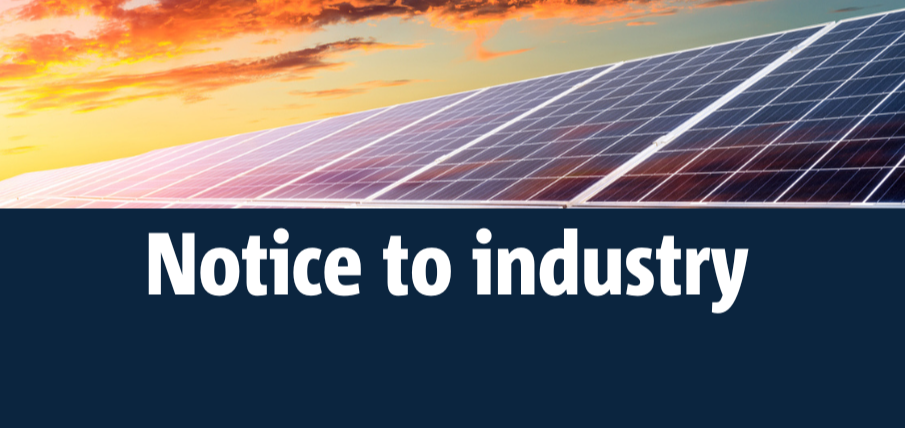Attention: Update issued on SA's Dynamic Export Requirements

Applying for embedded generation to be installed after 1 July 2023? Make sure you stay ahead with the latest updates.
This update follows Notice to Industry on SA’s Dynamic Export Requirements and Flexible Export Rollout comes into effect from 1 July 2023.
Recap of the changes from 1 July:
From 1 July 2023, the Government of South Australia is introducing Dynamic Export Requirements, requiring most new and upgrade exporting solar generation systems to be capable of remotely updating their export limits.
To coincide with these requirements, SA Power Networks will commence the progressive rollout of Flexible Exports as a standard connection option. The rollout will commence on 1 July 2023 beginning with 37 suburbs currently in the Flexible Exports trial area, and will be expanded to more suburbs in the Cities of Mitcham and Onkaparinga in the following months. Our intention is to have Flexible Exports rolled out state-wide by mid-2024. Make sure to use the Eligibility Checker to check if your customer is eligible for Flexible Exports.
Latest updates to the Government requirements:
In response to feedback from industry, the Government of South Australia has made the following changes to the Dynamic Exports requirements, which were published in the Technical Regulator Guidelines on 26 June 2023:
- Medium Embedded Generator (MEG) requirements: The requirement for MEG systems (30-200kVA export) to be Dynamic Exports Capable has been delayed from 1 July 2023 to 1 July 2024. This will allow greater time to develop and test Flexible Exports for MEG systems prior to mandatory requirements coming into effect.
- Relaxation of requirements for installations outside Flexible Exports eligible suburbs: Systems installed outside Flexible Exports eligible suburbs (where the 5kW/phase export limit is still available) will need to include dynamic exports capable inverters. However, you will not need to include the installation of any additional hardware otherwise required to make the site dynamic exports capable (including export monitoring and gateway devices). Additionally, if the installation is part of an upgrade, any existing inverters can remain as-is.
If one of these customers later wishes to opt-in to a Flexible Exports connection option, the additional hardware must be installed, and all inverters (new and legacy) must be brought under the site-wide export limit. Ensure you talk to your customer about their options as part of the sales process.
The following table summarises the equipment that is required to ensure your site meets the dynamic export regulations:
| Dynamic export requirements | |||
|---|---|---|---|
|
|
Dynamic Export capable inverters required | Export monitoring device required | Gateway device required |
| Outside of Flexible Exports eligible suburbs (5kW/phase export limit applies) |
Yes | No1 | No |
| Within Flexible Exports eligible suburbs (1.5kW/phase or flexible export limit applies) |
Yes | Yes | Maybe2 |
| Zero export installations | No | Yes | No |
1. Export monitoring / limiting device required if inverter capacity is greater than 5kW/phase to ensure the 5kW export limit is adhered to.
2. Only required if the inverter needs a gateway device to achieve dynamic exports communication. This information can be found on the list of dynamic export capable inverters described below.
How to find the latest list of Dynamic Exports Capable Inverters:
Dynamic export capable inverters are those that are compliant with the dynamic export regulations either through native or gateway-based communications. The latest information can be found on:
- Clean Energy Council (CEC) inverter list. Look out for inverters with ‘Software client’ column filled in – it means that they meet the dynamic export requirements and describes how they meet the requirements (either inverters have inbuilt capability or require a supporting gateway device). The CEC is also currently maintaining a separate pdf list titled “Inverters with Software Communication Clients”; or
- SA Power Networks’ Deemed to comply list. As part of the transitional arrangement, SA Government has published the minimum set of functions required for transitional certification of devices. You can sell and install these devices from 1 July 2023 as they are deemed to comply with the dynamic export requirements. However, all devices installed after 1 April 2024 will need to complete the full certification and appear on the CEC’s inverter list.
What can I do to be ready?
- Check out the Notice to Industry issued on this matter for further details, including training available.
- Attend a free face-to-face training on 24 July 2023, which covers inverter manufacturer specific information on how to install dynamic export capable equipment and successfully commission Flexible Exports sites.
For more information
- Check out Dynamic Export Limit requirements page and the Technical Regulator Guidelines on the SA Government regulatory requirements.
- Email New Energy Services newenergyservices@sapowernetworks.com.au or call us on 13 12 61 (Monday to Friday, 9am to 5pm).